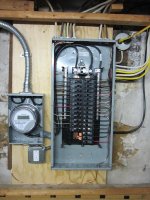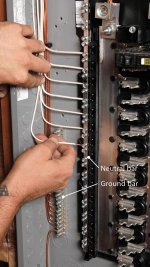ericsarratt
Senior Member
- Occupation
- Utility Contractor, HVAC Service Tech, Septic Installer & Subsurface Operator, Plumber
I have been watching Mike Holt's video on Grounding, System and Equipment [250.4, 2020 NEC].
In the video he says that lightening travels so fast that it doesn't take curves well because of skin effect. As a result of this, it is best to avoid unnecessary bends and loops in the grounding wire.
Here is the video:
However, in electrical circuit breaker panels some electricians put in drip loops (really a bend) in the ground wires. They also create right angles with the 6AWG wire which goes to the grounding rod (to make it neat and pretty).
Given this nature of lightening, shouldn't the grounding wire which goes to the ground rod be attached vertically at the bottom of the grounding bar? Then the wire should go straight out the bottom of the box and straight to the grounding rod?
In the video he says that lightening travels so fast that it doesn't take curves well because of skin effect. As a result of this, it is best to avoid unnecessary bends and loops in the grounding wire.
Here is the video:
However, in electrical circuit breaker panels some electricians put in drip loops (really a bend) in the ground wires. They also create right angles with the 6AWG wire which goes to the grounding rod (to make it neat and pretty).
Given this nature of lightening, shouldn't the grounding wire which goes to the ground rod be attached vertically at the bottom of the grounding bar? Then the wire should go straight out the bottom of the box and straight to the grounding rod?



